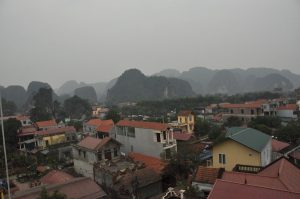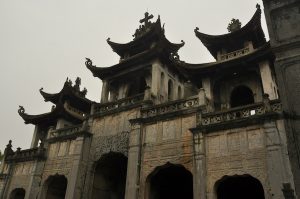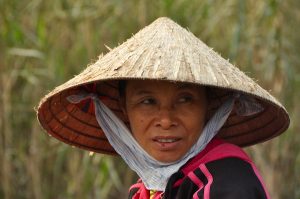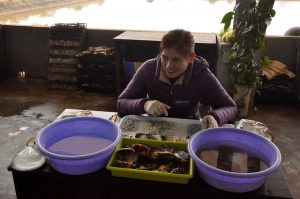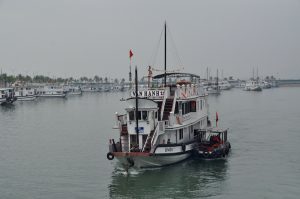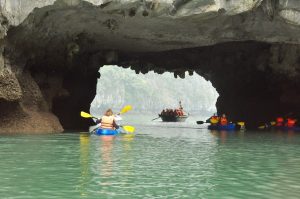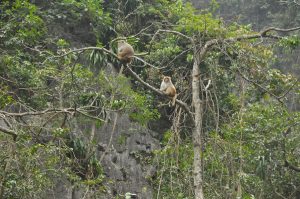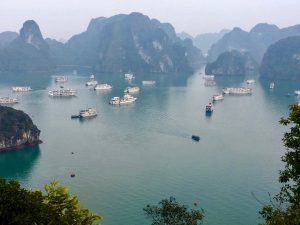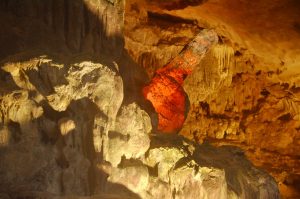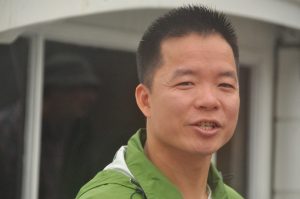The drive to Ninh Binh became more interesting the closer we got. Having left the mountains behind us we travelled through a very flat landscape of expansive paddy fields, big enough for machinery to plough and prepare rather than bent double men and women. Great sluggish rivers cut their way through the flat landscape. At various points along their length, large barges were moored, home for the Tet Festival. Normally these barges ply their way up and down stream carrying a wide variety of cargoes, but mainly sand and limestone for building purposes. Then, out of the haze, enormous towers of vertical rock emerged. There were no preparatory hills gradually increasing in size, just great lumps of limestone karst scenery. As soon as it appeared, it disappeared again, making way for more flat, watery paddy fields. Again, the karst scenery reappeared and by the time we reached Ninh Binh, the town was surrounded by these strange outcrops. The view from our room on the 7th floor of the hotel looked out on to the building below, dwarfed by the towering blocks of limestone. That night we ate in at the Nam Hoa Hotel.
The following morning Mr T took us, on our bus, to visit Phat Diem Cathedral. This area of Vietnam has quite a significant Catholic population and the landscape, en route to Phat Diem, is littered with churches. The landscape was now very flat with massive paddy fields disappearing as far as the eye could see, all fed by a network of canals. Much of this area had once been submerged but with the careful management of a canal system the land was reclaimed. Thousands of tons of limestone had to be transported to create a firm foundation for the cathedral, built in the late 1800s. The stone for the construction had to be transported some 120 miles along with timber from hundreds of ironwood trees. Although it is a cathedral, upturned pagoda styled roofs were placed on top of the towers, giving it a unique appearance.
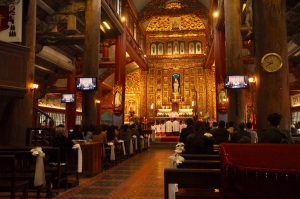 Before we entered the Cathedral we could hear singing. A wedding was taking place. The atmosphere inside was relaxed and the singing beautiful. Obviously, we kept a respectful distance from the ceremony but nobody seemed to mind us being there and taking photographs. All along the nave, huge ironwood pillars supported the wooden vaulted ceiling. The area behind the altar was ornately gold the centre piece being a statue of Mary and baby Jesus with a blue neon halo and ‘Ave Maria’ above her head. It was all slightly gaudy.
Before we entered the Cathedral we could hear singing. A wedding was taking place. The atmosphere inside was relaxed and the singing beautiful. Obviously, we kept a respectful distance from the ceremony but nobody seemed to mind us being there and taking photographs. All along the nave, huge ironwood pillars supported the wooden vaulted ceiling. The area behind the altar was ornately gold the centre piece being a statue of Mary and baby Jesus with a blue neon halo and ‘Ave Maria’ above her head. It was all slightly gaudy.
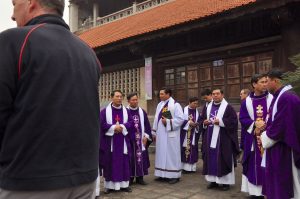 From outside, more singing could be heard, and now it was competing with the wedding ceremony. There was a funeral taking place. It seemed strange that there should be two completely different services competing with each other. Walking by the funeral, it looked as if it might be that of a priest as there were so many frocked clergy participating.
From outside, more singing could be heard, and now it was competing with the wedding ceremony. There was a funeral taking place. It seemed strange that there should be two completely different services competing with each other. Walking by the funeral, it looked as if it might be that of a priest as there were so many frocked clergy participating.
Heading back towards the limestone karst scenery we next visited Dinh and Le Temples, a large complex of temples celebrating the kings of the Dinh and Le Dynasties of the 10th Century when Hoa Lu was the capital of Vietnam for a period of 41 years. Mr T gave us the low down on its history but there was far too much to take in and absorb. The temples are all that remains of a much larger complex known as the Citadel.
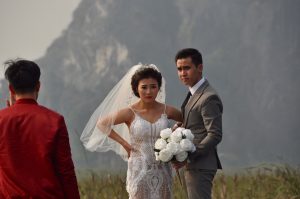 After lunch we headed down to an area known as Tam Coc (Halong Bay on Land) for a boat trip. Waiting on the water were a number of sampans, largely paddled by women, to take us on a journey through the quiet waters with limestone cliffs rising vertically above them. Initially, we paddled through channels among reeds. As we did so, we came across a bride and her groom, in full wedding gear, standing on a sampan while a photographer on another sampan took their pictures.
After lunch we headed down to an area known as Tam Coc (Halong Bay on Land) for a boat trip. Waiting on the water were a number of sampans, largely paddled by women, to take us on a journey through the quiet waters with limestone cliffs rising vertically above them. Initially, we paddled through channels among reeds. As we did so, we came across a bride and her groom, in full wedding gear, standing on a sampan while a photographer on another sampan took their pictures.
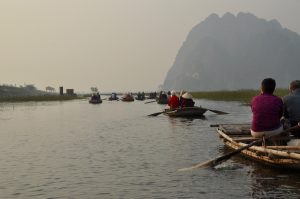 It was such a peaceful way of travelling with just the rhythmic sound of the paddles rippling the water. Egrets perched in colonies on the branches of trees by the water’s edge. We followed the line of a limestone cliff to its end and then turned a corner so that we now had cliffs on both sides. The scenery was so dramatic in every direction. Our eyes were drawn to the rocky cliffs surrounding us for we knew there were monkeys in the area and we were keen to spot some.
It was such a peaceful way of travelling with just the rhythmic sound of the paddles rippling the water. Egrets perched in colonies on the branches of trees by the water’s edge. We followed the line of a limestone cliff to its end and then turned a corner so that we now had cliffs on both sides. The scenery was so dramatic in every direction. Our eyes were drawn to the rocky cliffs surrounding us for we knew there were monkeys in the area and we were keen to spot some.
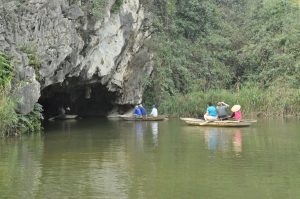 Further on we came to a low cave that just allowed us access to its darker corners before the roof became too low. Emerging from the cave we looked up and there we spotted some large black monkeys with, what looked like, white nappies around their bottoms. They were Delacour’s Langurs, a seriously endangered species. There are only about 250 left in the world and during the course of our observation, we saw about 12. They have extremely long tails which help give them balance as the nimbly run across the limestone cliffs.
Further on we came to a low cave that just allowed us access to its darker corners before the roof became too low. Emerging from the cave we looked up and there we spotted some large black monkeys with, what looked like, white nappies around their bottoms. They were Delacour’s Langurs, a seriously endangered species. There are only about 250 left in the world and during the course of our observation, we saw about 12. They have extremely long tails which help give them balance as the nimbly run across the limestone cliffs.
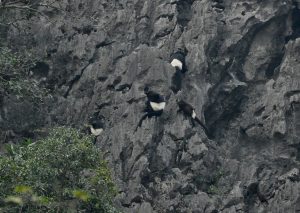 The reason there are so few left in the world is that they have been hunted vigorously for meat and for their bones and organs for medicine. Vietnam has a reputation for not looking after its wild life but it is beginning to realise that if it does not look after what it has got it will lose them for ever. Rangers are employed by the national parks to oversee their protection. Unfortunately, its close proximity to China means that there is always going to be a market, and if the rewards are great enough there is always someone willing take the risk. We really enjoyed watching them watching us. Hopefully, they will survive and begin to flourish in protected areas.
The reason there are so few left in the world is that they have been hunted vigorously for meat and for their bones and organs for medicine. Vietnam has a reputation for not looking after its wild life but it is beginning to realise that if it does not look after what it has got it will lose them for ever. Rangers are employed by the national parks to oversee their protection. Unfortunately, its close proximity to China means that there is always going to be a market, and if the rewards are great enough there is always someone willing take the risk. We really enjoyed watching them watching us. Hopefully, they will survive and begin to flourish in protected areas.
Tearing ourselves away, we began to head back. The lady paddling our sampan complained of sore hands, so I offered to take over. Carefully swapping places with her, I took the oars. The action is the opposite to what we normally do in a rowing boat. You face the way you are going, so instead of pulling the oars through the water, you push them. Believe it or not, that is quite a difficult concept for your brain to appreciate and you make little or no progress through the water. When I did begin to get the hang of it I started going round in circles. I think it is fair to say, that I did not get the hang of it. It seemed only right and proper to hand the oars back to the expert and let her guide us back to the jetty.
It was a brilliant trip, so much more so because we had seen the Delacour’s Langur.
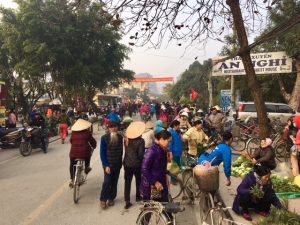 The next day we left Ninh Binh and headed towards Halong Bay. However, before we left, there was just time to enjoy the hustle and bustle of the early morning market that took place in the street either side of our hotel. It started very early, long before we were up and about. although we could hear them from our rooms. You could sense the excitement of the upcoming Tet Festival, very similar to the excitement that takes place in our own shopping streets in the lead up to Christmas.
The next day we left Ninh Binh and headed towards Halong Bay. However, before we left, there was just time to enjoy the hustle and bustle of the early morning market that took place in the street either side of our hotel. It started very early, long before we were up and about. although we could hear them from our rooms. You could sense the excitement of the upcoming Tet Festival, very similar to the excitement that takes place in our own shopping streets in the lead up to Christmas.
I was really looking forward to Halong Bay as it had been on my wish list for many years. Before we boarded our boat we had to visit a pearl emporium where we were shown how the irritation was placed in the flesh of the oyster in order for a pearl to form. We also observed how the pearl was taken out. I was amazed to learn that a single oyster could go through the pearl producing process three times. Having watched the process, we were then ushered into the shop. That is when I switched off. It was large, very well staffed with sales people everywhere. Unfortunately, pearls leave me cold and the prices asked added to my lack of enthusiasm. I didn’t really need this distraction, this delay. I wanted to get on the water and sail among the towering pillars of Halong Bay.
In order to get to the jetty, we had to drive across a causeway which led to an area of development, with several hotels in various stages of completion. A lot of money is being invested in developing this area, although some of the sites appeared to have ground to a halt before they were finished.
On the water were hundreds of white painted junks of all sizes. Some were more luxurious than others. They were all white. This is a relatively recent innovation for before the junks were all natural, wood coloured. They look OK white but as white boats the paintwork needs to be touched up regularly, or they begin to look tatty. If you look closely the quality of paint work is not particularly good. Most people prefer them as they were. There are a number of theories as to why the decision was made to paint them. Some say it was to create job opportunities, others that had seen white cruise liners and were inspired. A local paint manufacturer wanted to boost his sales so persuaded the authorities, probably with an incentive, to change the laws. One of the problems with nothing but white boasts that they are difficult to see in a sea mist, and Halong Bay has its fair share of foggy days.
We were to have two junks, with half the group sleeping on each. Tenders took us and our luggage out to our junks moored in the middle of the harbour. As soon as we were aboard the tenders were moored up to the junk and off we went.
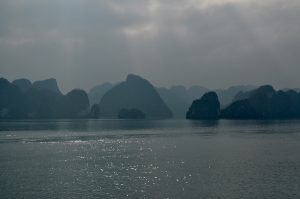 As soon as we were out of the harbour a gourmet lunch of fresh fish and prawns was served. Outside, towers of rock rose vertically out of the sea, and the further we went the better it got. As good as the food was it was impossible to concentrate on it as the scenery unfolded outside. Soon the meal was over, and we were able to go up on deck and take in the amazing scene. Sadly, it remained cloudy and we did not get the blue sky reflected in the water. Instead, we got dark, brooding, moody pillars of rock rising threateningly out of dark waters. It was so atmospheric.
As soon as we were out of the harbour a gourmet lunch of fresh fish and prawns was served. Outside, towers of rock rose vertically out of the sea, and the further we went the better it got. As good as the food was it was impossible to concentrate on it as the scenery unfolded outside. Soon the meal was over, and we were able to go up on deck and take in the amazing scene. Sadly, it remained cloudy and we did not get the blue sky reflected in the water. Instead, we got dark, brooding, moody pillars of rock rising threateningly out of dark waters. It was so atmospheric.
Weaving our way through narrow passages of water, we were not alone. There were many more junks on the water heading out to our eventual destination, a mooring area across the water from Titov Island. Once we were moored we boarded our tender to take us to a landing stage before the entrance to Luon Cave. here, we had a choice of either hiring two-man canoes or being taken there on a large sampan. Most of us chose the canoe option.
Now I have done a fair bit of canoeing in my time and I like to think I know what I am doing. But these were not Canadian or sit in canoes; they were sit on ones. Deciding to take the rear seat I gently eased myself on to my canoe. Unfortunately, I misjudged my positioning and planted my backside on the edge of the small back support. This tipped me back and the stern of the canoe under water with my backside following. I wasn’t worried about my own self-being but I was concerned that my wallet, with passport, was getting a good soaking, along with my camera that had succumbed to gravity. My pride was a little dented as I found it impossible to haul myself back up. It took some effort from me and those helping me to haul me up, while everybody else around me was laughing far too heartily. Having assumed the right position, Angela then nimbly took her seat and we paddled off out of the public glare. Once away from the jetty I could check that my camera still worked. It did. Phew!
Luon Cave is a low arch leading into a hidden lagoon of enormous proportion. Once through, you are faced with a circle of vertical, or near vertical rock and vegetation, which enhanced, yet muted, the voices of the people paddling around. We paddled fairly close to the cliffs in the hope of seeing some of the golden monkeys that are reputed to live around the lagoon. We were just about to leave, when we saw some, so we paddled across to take a closer look as they sat in a tree watching us watch them.
When we returned to the jetty I was accosted by an American lady who thanked me for giving her the best laugh ever and a lasting memory of me floundering half in and half out of Halong Bay. My pleasure!
From the jetty our tender took us across to Titov Island where we were able to take the steps up to the summit for a panoramic view, or not. Despite feeling very uncomfortable in the trouser department, I decided to climb the 420 steps for the view. It was well worth it as it gave a fabulous impression of the vastness of Halong Bay and just a fraction of its 1600 islands. It was stunning and I could have spent more time up there just absorbing every detail of the view.
Back on our boat I spread my money out on a towel, my passport, dried my camera and discovered that my battery power banks no longer functioned. It could have been worse.
That night we had an absolutely fabulous meal that included oysters, giant prawns, fish and a lot more besides, with the lights of various boats shimmering across the water. Afterwards it was great to sit up on deck with a beer in hand and look across to the other boats and listen to their laughter as others, like us, enjoyed being in Halong Bay.
The next morning, after breakfast, our tender took us across to the jetty on Bo Hon Island to visit a cave system called Hang Sung Sot (Surprise Cave). Climbing the initial flight of steps gave us yet another superb aerial view of the bay below. However, I don’t think I was prepared for the enormity of the cavern we entered. It was huge. It was broken down into three enormous chambers all suitably lit with the main features highlighted. The stalactites, if you release your imagination, form shapes resembling Buddha or a large tortoise. But by far the most famous, and the easiest to understand is the giant phallus standing proudly and glowing a dangerous shade of red. It is in serious need of some soothing cream. Funnily enough, when you walk on the other side of this feature it looks nothing like a giant penis.
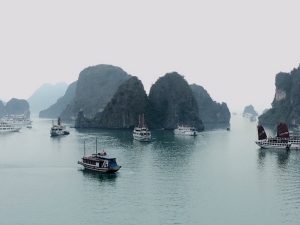 Our time in Halong Bay was coming to an end. Once we had finished in the cave our tender took us back to our junks and we soon set off on the return journey to Halong City. It was still grey and murky but it did not diminish the splendour or the impact of the rocky pillars. It may have diminished their features but they were swathed in far more atmosphere.
Our time in Halong Bay was coming to an end. Once we had finished in the cave our tender took us back to our junks and we soon set off on the return journey to Halong City. It was still grey and murky but it did not diminish the splendour or the impact of the rocky pillars. It may have diminished their features but they were swathed in far more atmosphere.
Our bus was waiting to return us to Hanoi where we were to board the night train to Hue and embark on the next stage of our Indochina adventure.
Sadly, it was also time for us to say our farewells to Mr T. I have had a great many guides over the years, but few have been better than Mr T. He endeared himself to the group with his attention to duty, giving us information that helped us to understand the intricate history of Vietnam, his jokes at the expense of the Chinese, his excellent organisation, his care and his smiley personality. There was visible emotion as he hugged each of us in turn. When he left us he was heading back home on his motorbike to join his wife and children, to celebrate Tet, before starting all over again with a new group. If I go back to Vietnam, and I certainly hope I do, I would like to think that Mr T and I could work together again.

